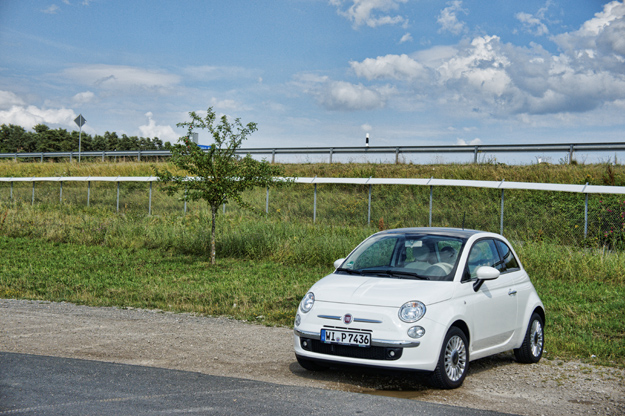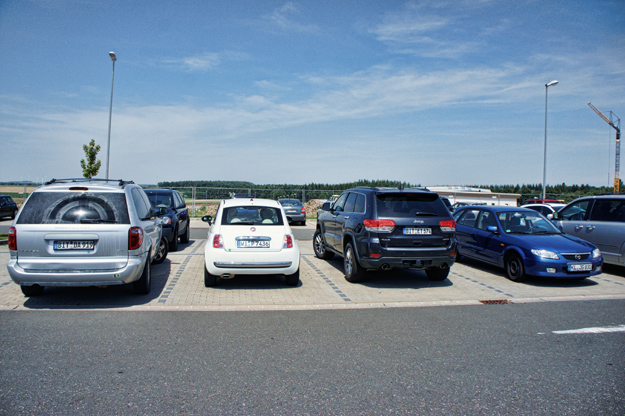2013 Fiat 500 Pop and 2012 Fiat 500 Sport — Review
© 2014 Peter Free
23 July 2014 (revised 21 August 2014)

Fiat 500 — pretty darn good for its intended purpose
The 2013 Fiat 500 Pop and 2012 Sport are good cars that do more, more capably than most American reviews give them credit for.
Caveat
In evaluating this review, keep in mind that I have an econobox mentality, meaning a “get from A to B cheaply and reliably” perspective on cars. I am less concerned with achieving a race car feel — than I am with (a) being able to get into and out of the car easily and (b) having my spine survive while driving it.
Test conditions
I drove an automatic Fiat Sport 500 in Colorado Springs late last year and rented the 2013 German version of what Fiat calls the Pop in the United States, during the summer of 2014.
As of this writing, I’ve put about 2,500 miles (4,000 kilometers) on the German version of the Pop.
More room than expected
There is a surprising amount of shoulder room in the front of this car. Seating position is higher and can be positioned more uprightly than is usually the case.
Door openings are tall enough that getting in is not at all a problem. Entry is easier than quite a few much larger cars that I have driven.
The hatch lid raises higher than most other cars. Hitting one’s head, even if tall, is unlikely.
We fit 6 suitcases into the Pop by folding its back seats down. On one occasion, I put a boxed 21 inch lawnmower in the back. The 34 ¾ x 17 ¾ x 23 ¾ inch (88.3 x 45.5 x 60.9 centimeter) package fit without difficulty. In both cases, there was still plenty of room for an assortment of briefcases, daypacks, and grocery bags — as well as for the driver and front seat passenger.
After using the Pop to make three luggage plus boxes moves in Germany, I give the Fiat 500 a high score for the space it offers for such a small car. Volume and practical capacity for two people on a trip is not a problem. Reviews that disagree obviously did not test the car’s actual capacity.
Driving characteristics — great for cities and adequate on the Autobahn
The 500 was clearly designed as a city car. It is so small that it fits just about everywhere, which is a gift on Europe’s narrow and often crowded streets. Handling is nimble, like a gnat. Parking is a breeze.

The car’s short wheelbase does require more concentration to keep straight at high Autobahn speeds. This is, however, more perception than reality. Steering and road feedback gives the impression that the car will dart out from under one at 130 kilometers per hour (81 mph). But, in fact, if one can takes one’s hands off the wheel, the car maintains a straight line.
That said, I found the 500 more difficult to drive relaxed and lap-handed than most larger vehicles. The short wheelbase requires two hands for confidence, in part because irregularities on the road surface tend to throw it momentarily off balance more than longer cars.
I only became genuinely concerned about the short wheelbase at 160 kph (99.4 mph). At that speed, the car is noticeably too squirty and skippy feeling. A relaxed high speed cruiser, it is not.
Power
Most reviews are critical of the Fiat 500 non-turbo’s lack of zip. I would agree, when driving the car at Colorado altitudes. I would not consider the base engine for use in North America’s Rockies or Sierras.
On the other hand, if drivers are willing to shift down — which is easy on either the manual or the automatic — the car does an adequate job on southwest Germany’s Autobahn.
Admittedly, fifth (top) gear in the manual will not pull adequately up even gentle grades at 130 kilometers per hour (81 mph).
Downshifting into fourth will. It does, however, take a slow grind up the speedometer to regain the speed that one lost.
Note
130 kph is the government’s recommended speed on the Autobahn.
Americans accustomed to V8s will not like this lack of instant power, but it did not bother me. On the plus side, the slow acceleration uphill in fourth gear does not top out on the gentle hills near where I live. Going faster than 130 kph is easily possibly up the 5 percent grades in our region of Germany.
Ride
As one would guess, the 500’s ride is somewhat harsh and often choppy, especially over bumps. This is unavoidable with such a short and comparatively inexpensive car. At no point did I find either model distasteful for this reason. (Of course, I’m accustomed to driving older full size American pickups, none of which were noted for the luxurious quality of their unloaded rides.)
Automatic versus manual
I preferred the automatic Sport to the manual transmission Pop. The seating and clutch pedal ergonomics of the manual force me closer to the steering wheel than the auto does. I also find that repeatedly having to clutch torques my lower back in ways that it doesn’t like.
Fiat’s six speed automatic is a decent transmission. I see no reason to avoid it.
The manual transmission displays a couple of irritations. Most of the reviews that I have read comment on these.
The gear shift throws are a bit long (fifth especially so), and one occasionally is not sure whether one is headed for first or third. The driver’s display also recommends upshifting far before it makes sense from an available power perspective.
Another minor gripe is clutch engagement. It catches low to the floor and more abruptly than (I think) most drivers would like. Inadvertent minor lurching in first and sometimes second gear occurs, unless you get everything timed more perfectly than is usually necessary in a manual transmission car.
Smooth as butter, this car is not. I’ve owned a host of manual gear box pickup trucks that shifted far more smoothly than my rented Fiat 500 does.
User interface
The dash is very simply laid out and setting some media functions is not obvious. On the other hand, climate control is a snap. And one quickly gets used to the window controls being adjacent to the shifter.

Unlike a lot of other cars, I had no trouble figuring out how to work the Fiat’s controls. (Recent Fords spring to mind as especially obnoxious demonstrations of how not to design user interfaces.)
Biggest negative? — Poor visibility to the rear sides
The roof pillars on the Fiat 500 are comparatively wide compared to the length of the side widows.
Additionally, the head restraints on the rear seats block the view to the right rear. The combination means that it is impossible to reliably see traffic coming from either the right or the left behind the car. (Visibility straight back is fine.)
Being in Germany compounds the rear visibility problem. Side streets are very narrow. Laterally moving traffic behind a head-in (off street) parking space is closer than it is in the United States. There is less room for error before someone crunches into your car, as you try to back it into the traffic flow.
As a cautionary note, Germans seem to be rather cavalier about allowing trees, bushes and other visual obstructions to butt right up to the street. It is often impossible to see traffic coming from the left until one’s car nose or rear end is already into the street.
Versus the Mini Cooper
Reviews usually compare the 500 to the Mini Cooper S. I have not driven a Mini for the simple reason that I suffer in its seating position. Too low and uncomfortable. Not a good car for someone as arthritic as I am. Part of my affection for the Fiat is its ease of entry, firm driver’s seat and upright seated position.
My guess, given that they could have taken aim at the Mini, is that Fiat’s designers were looking for something cheaper, more relaxed and easy to live with than the Mini. Ergo the 500. The 500 is noticeably less expensive, easier to get into, displays a more compliant suspension. It may also be, according to some reports, mechanically and electronically more reliable than the Mini.
Versus (for example) a 2010 Subaru Outback
My wife’s Outback arrived from the States roughly two months into this Fiat rental. By comparison, it is a heavy behemoth. Where the Fiat fit tinily into the small German garage attached to our rental house, the Subaru’s length fills the whole thing up. The same is true when pulling into Germany’s relatively narrow parking spaces.
The Subaru feels heavy and drives with less sprightliness. On the other hand, one feels a good deal safer in it, especially at Autobahn velocities. The very solid all wheel drive Subaru will easily outrun the Fiat on the highway. But it will fall back on noticeably twisty roads.
Here in cramped Germany, I prefer the sparkly Fiat. It’s simply more fun in its comparatively tinny, zippy, puppy-like way. My wife, on the other hand, much favors the Subaru. As would, I am certain, the overwhelming majority of Americans. The Subaru is unquestionably a better and more practical family car.
Who might be interested in these tiny Fiats?
The Pop and non-turbo Sport may appeal to city dwellers, who only occasionally have to drive on the Autobahn or Interstate.
I do not think the car is a competent enough highway cruiser to interest people who have to regularly drive on western US Interstates.
The moral? — For my “stay out of trouble and go places in and around Germany” purpose, the Fiat 500 is a winner
For me, the car’s nimble size beats the trade-off of having to pay more attention to keeping it steady on the Autobahn.
Most Americans’ tastes will go the other way. That is almost certainly why Fiat came out with the 500L not long after the 500 came out. The longer and significantly larger 500L is reportedly a better car for most North American purposes.
On balance, in regard to the tiny original Pop and non-turbo Sport, I care more about being able to drive comfortably down narrow, crowded streets with limited parking, than I do about keeping up with speedy Audis and BMWs on the Autobahn. The two original models also do reasonably well on the narrow, twisty roads of rural Germany.
I like these 500s a lot. Their driver’s seat is the only small car seat that I have been able to tolerate for more than a few minutes. The Sport has a firmer suspension than the Pop, which I also appreciate.
Were I to buy a 2015 Fiat 500, it would be the de-tuned turbo version. The extra power would be welcome. (This is the non-Abarth turbo.)
In regard to the backing visibility problem, I now try to back into spaces whenever the traffic flow that I’m coming from allows.
 PeteFree.com
PeteFree.com